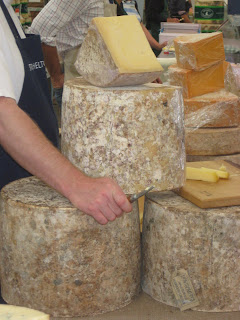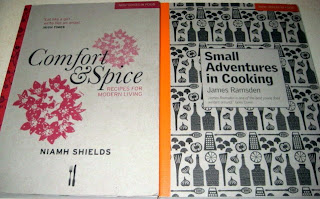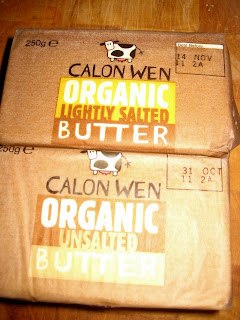Cheese, Caws, Cais – no matter what language you use Cheeses of all varieties and from whatever country all have something to offer and all – being living things – are different.
In case you did not know Caws and Cais are the Welsh and Gaelic words for cheese, and entirely appropriate as they all came together at the Great British Cheese Festival in Cardiff. Held in the Castle Gounds the festival really does live up to the word Great, some of the finest cheesemakers around show their wares and compete for major awards.
I have always loved cheese, but I really got into a deeper understanding at Ballymaloe Cookery School. A cheese board was an integral part of lunch everyday – indeed my innovative use of fresh Mulberry Leaves from the fruit garden as a base layer for the range of cheeses got high praise from Darina Allen
Wednesdays were Theory Days but there was always a tasting from an Artisan Cheesemaker at the start of the day. Hearing about their cheeses and their production and maturing got my interest up massively. Oh yes and we had practical demonstrations of cheese making using the milk from the farm’s Jersey cow, and the chance to make cheddar style cheese was an integral part of the course.
Inevitably I developed a passion for Irish Artisan Cheeses. and there were a great range on show at Cardiff. There were also a huge range of English and Welsh Cheeses on show though I did not notice many from Scotland. Having hit the really good cheeses in the cheese yard at the Abergavenny Food Festival fairly hard last week I did concentrate on Ireland ,but still tasted and purchased some brilliant offerings from the UK.
I was pleased to see a large number of Unpasteurised Milk cheeses, particularly as Raw Milk is under threat, the use of unpasteurised milk really does add a depth of flavour that treated milk cannot. Though the Irish Government is planning to end the sale of raw milk to the public they claim that its use in Cheese will not be affected. Over here the Food Safety Agency are also lobbying for a change but it is a lot less clear whether cheesemakers will be exempt.
Anyhoo, as I tasted my way around the main pavilion my bag began to fill with great Sparkenhoe,a Raw Milk Red Leicester just milk, rennet annatto (natural colouring) and a little salt. Made on the farm, Sparkenhoe is definitely the best Red Leicester I have tasted. The farm also makes a blue cheese which they cannot call Stilton as they are just outside the geographic area for DOP.
A Winterdale Shaw unpasteurised, cloth wrapped, cellar matured strong hard cheese from Kent followed rapidly as the rich taste teased my taste buds and awoke my underlying craving for strong cheese.
The brilliant Hafod, a strong West Wales cheese dear to Darina’s heart followed and a Smelly Teifi (think Stinking Bishop but with attitude) concluded my initial purchases.
At that point Mrs K reminded me that we were due in the “House of Commons Tent” for a tasting of Irish Artisan Cheeses so shopping ceased and education took over.
The session for about 20 of us was led by Jane Murphy of Ardsallagh Cheeses, an East Cork producer of Goat Cheese. I first came across Jane at Ballymaloe where she did one of the Wednesday sessions and gave us a tasting of her fresh and aged cheeses, two of which were on the tasting plate today. Jane also told us how she got started when; in a random act of kindness a travelling insurance salesman gave her an in-kid goat as the milk would help her children’s eczema.
Jane now milks about 1,000 goats from 3 farms and has most of her family working in the family business. Not bad for someone who was only given a goat for medicinal purposes.
Before Jane’s fresh and matured cheeses we tried a Killeen goat with fenugreek seeds. This had been voted the supreme champion cheese and tasting it you could see why. To accompany these cheeses we had a light Chilean Cabernet Sauvignon which showed why cheese and wine are natural partners.
The on to the washed rind tasters – accompanied by a Gwynt y Ddraig Cider. The first was a Milleens, the cheese which started the whole Irish Artisan revival. Milleens is recognised as the first entirely unique cheese type in Europe for over 200 years. Quite soft, with an extra taste delivered by the rind, the combination with cider again seemed natural.
The second was a Durrus again made in County Cork, probably the second cheese I fell in love with in Ireland. Again washed rind, again the rind gives a second flavour that rounds the cheese.
A discussion about rind washing ensued did producers use brine, wine, mead; vinegar etc. to create the mould that formed the rind over time?
This led us to discuss Gubbeen made by Giana Ferguson in Schull County Cork. (The Fergusons use the whey from their chesses to feed the pigs that become the excellent Gubbeen charcuterie.)
Giana doesn’t make cheese in January but was so worried that the spore that makes the distinctive rind might die during the layoff that she sent a sample for analysis so that, should the worst happen, she could locate a new supply of spore. Eventually the reply came that the spore had been analysed and was totally unique to Gubbeen. In fact it has now been named “Gubbeenensis”. As Jane joked “make cheese and name it yourself, and have a mould named after you as a bonus”.
Anyone spot the similarity with Sourdough bread where the yeasts in the air make each culture unique?
Finally with a citrus flavoured beer as the accompaniment we moved on to two iconic Irish Artisan Cheeses. Coolea, a rich Gouda style cheese “We can’t call it Gouda as our milk is too rich” which was at the forefront of the cheesemaking revival and Cashel Blue – possibly the best rounded blue cheese of all. Think young gorgonzola, but with a buttery creaminess and you are on the way. I love to bake a tart with Cashel Blue, Walnuts and sweated shallots!!
Tasting over back to the main pavilion to buy the cheeses that we had tasted and some others as well such as Crozier Blue, made by the cousins of the Grubb family who make Cashel but ewes milk instead and the absolutely outstanding Cais Dubh (black cheese named for its wax coating) from Fermoy. Only a little of this cheese is made each year so to find it in Cardiff was wonderful and a couple of hundred grams found its way into my bag. My only regret was that the superb hard cheeses Gabriel and Desmond (kind of Irish Parmesan) were not available at the show. Oh well, another reason to go back to Ireland.
The bag caused great hilarity to Jane and Siobhan Murphy when I bought from them. We have loads of sustainable shopping bags at home and randomly Mrs K had selected a Hurley's of Midleton bag. Jane sells in the Farmers Market outside Hurley's every Saturday and huge blow up photos of her can be found both inside and outside the store.
Eventually with arms extended several inches by the weight of cheese filling my shopper I left to plan menus and ensure that the cheeses would be used to their greatest advantage.
You understand why it is the GREAT British Cheese Festival when you go and I think it a shame that there are another 363 days before next year’s.
Visit UK Food Bloggers Association

















































